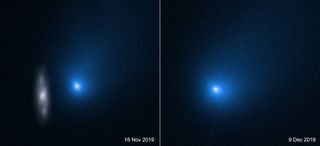
Two new "ghostly" images catch the first observed interstellar comet whizzing by the sun and in front of a distant, spiral galaxy on the object's way back out of our solar system.
On Nov. 16 and Monday (Dec. 9), NASA's Hubble Space Telescope snapped two incredible and ghostly new photos of the interstellar comet 2I/Borisov, the first interstellar comet ever observed. Amateur astronomer Gennady Borisov first spotted the comet on Aug. 30.
Borisov's discovery was the first of its kind. While 'Oumuamua, an interstellar asteroid, was discovered in 2017, this object, also known as C/2019 Q4, is the first-ever interstellar comet that humans have spotted.
Related: How to Find an Interstellar Comet: A Q&A with Gennady Borisov
More: Hubble Telescope Spots Interstellar Comet Borisov (Video)
"This object is, we believe, a visitor from interstellar space. It was discovered in August of this year, and based on what its observations and its orbit, we believe it is a comet from another planetary system," NASA planetary astronomer Heidi Hammel said during a discussion about 2I/Borisov on NASA TV's media channel on Friday (Dec. 13).
In the first of these new images, taken on Nov. 16, the comet was approximately 203 million miles from Earth, seen in front of a distant spiral galaxy known as 2MASX J10500165-0152029, according to a NASA statement. You can see the comet's tail of dust up to the right. You can also see that the object's bright core looks smudged, as Hubble was imaging the object while also tracking its movement.
In both images, 2I/Borisov has been artificially colored blue so that details can be seen in the coma, or envelope of dust and material that surrounds the comet's core, or nucleus. This coloring also makes it easier to tell the comet apart from the spiral galaxy in the image from Nov. 16, according to NASA.
In the second image, taken Dec. 9, Hubble spotted the comet after it made its closest approach to the sun. On this close pass, 185 million miles (298 million kilometers) from Earth, 2I/Borisov reached speeds of 100,000 mph (160934 km/h).
2I/Borisov is a strange object that is likely no more than 3,200 feet (about 1 km) across, or about the length of nine football fields, NASA said. Scientists expect that the comet will make its closest approach to Earth later this month, in late December, as it passes at 180 million miles (290 million km) away.
By taking images like these with Hubble, an almost-30-year-old telescope, scientists are learning more about the object, like its size. That research will support the study of interstellar objects in general, scientists said.
"Hubble gives us the best upper limit of the size of comet Borisov's nucleus, which is the really important part of the comet," David Jewitt, a University of California, Los Angeles, professor of planetary science and astronomy, whose team analyzed and interpreted the data from these new Hubble images, said in the NASA statement.
"Surprisingly, our Hubble images show that its nucleus is more than 15 times smaller than earlier investigations suggested it might be," Jewitt said. "Our Hubble images show that the radius is smaller than half a kilometer [0.3 miles]. Knowing the size is potentially useful for beginning to estimate how common such objects may be in the solar system and our galaxy. Borisov is the first known interstellar comet, and we would like to learn how many others there are."
Follow Chelsea Gohd on Twitter @chelsea_gohd. Follow us on Twitter @Spacedotcom and on Facebook.

Science - Latest - Google News
December 14, 2019 at 07:42PM
https://ift.tt/2sojXbI
Interstellar Comet Borisov Shines in Incredible New Hubble Photos - Space.com
Science - Latest - Google News
https://ift.tt/2Kb7H4e
Shoes Man Tutorial
Pos News Update
Meme Update
Korean Entertainment News
Japan News Update
Bagikan Berita Ini














0 Response to "Interstellar Comet Borisov Shines in Incredible New Hubble Photos - Space.com"
Post a Comment